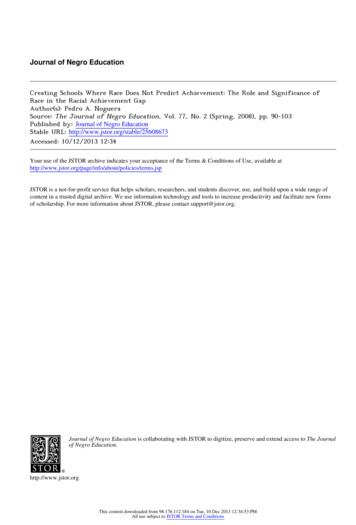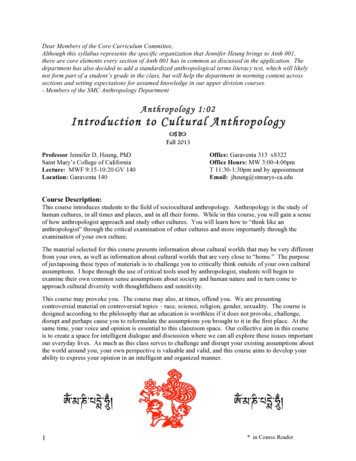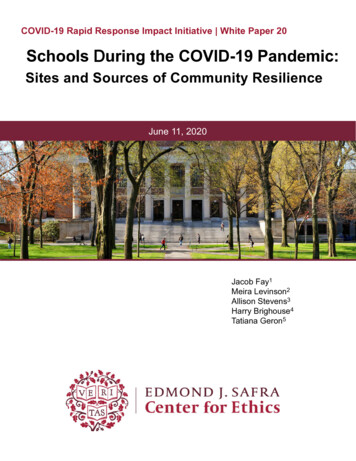
Transcription
Journal of Negro EducationCreating Schools Where Race Does Not Predict Achievement: The Role and Significance ofRace in the Racial Achievement GapAuthor(s): Pedro A. NogueraSource: The Journal of Negro Education, Vol. 77, No. 2 (Spring, 2008), pp. 90-103Published by: Journal of Negro EducationStable URL: http://www.jstor.org/stable/25608673 .Accessed: 10/12/2013 12:34Your use of the JSTOR archive indicates your acceptance of the Terms & Conditions of Use, available at ms.jsp.JSTOR is a not-for-profit service that helps scholars, researchers, and students discover, use, and build upon a wide range ofcontent in a trusted digital archive. We use information technology and tools to increase productivity and facilitate new formsof scholarship. For more information about JSTOR, please contact support@jstor.org.Journal of Negro Education is collaborating with JSTOR to digitize, preserve and extend access to The Journalof Negro Education.http://www.jstor.orgThis content downloaded from 98.176.112.184 on Tue, 10 Dec 2013 12:34:53 PMAll use subject to JSTOR Terms and Conditions
The Journal ofNegro Education,The 2007 Charles H. ThompsonPresentationColloquium77 (2), 90-103LectureCreating Schools Where Race Does Not PredictAchievement: The Role and Significance ofRace intheRacial Achievement GapPedro A. NogueraNew York UniversityThis article explores theways inwhich race is implicated in efforts to address the achievementgap inU.S. schools. Through an analysis of the theoretical and historical issues that have framedthe relationship between race and intellectual ability, the author explains why the effort to closethe achievement gap is politically and socially significant. The efforts of two suburban schooldistricts to address the achievement gap ispresented to illustrate why some schools are makingprogress in closing the achievement gap while others are not. These cases are used tomake a callfor a new discourse about the role of race in student achievement and to clarify how and why racecontinues to be so controversial and confounding to educators who are working to ensure that allchildren, regardless of theirbackgrounds, receive a quality education and have the opportunity toexperienceacademicsuccess.The effort to find ways to close or at least reduce the achievement gap?the disparities in testscores and academic outcomes that tend to follow well-established race and class patterns?hasbecome a national priority. Since the enactment of No Child Left Behind (NCLB, 2002) and itsrequirement that schools and students be held accountable for achievement through annualstandardized tests, a sense of urgency has developed over the need to improve the educationaloutcomes of under-performing students. Inmany communities, this has placed greater focus andattention on the need for strategies to improve academic achievement among children who havetraditionally not done well in school, namely, poor and disadvantaged children, students withlearning disabilities, recent immigrants and English language learners, and inmany communitiesAfrican Americans, Latinos and other students of color, generally (Miller, 1995).Those familiar with American history and the history of American education, in particular,will undoubtedly be struckby the ironyand significance of the currentnational preoccupation withclosing the racial achievement gap. Racial gaps in achievement, attainment and measures ofintellectual ability are by no means new. In fact, throughoutmost of American history, racialdisparities in educational achievement and performance were attributed to innate geneticdifferences between population groups, and as such, were regarded as acceptable andunderstandable "natural" phenomena (Fredrickson, 1981). Intelligence was regarded as an innatehuman property rooted in the particular genetic endowments of individuals and groups (Duster,2003), and therefore altering patterns of academic achievement was not regarded as feasible orevendesirable.Given this history, the fact that federal educational policy has made the goal of closing theracial achievement gap a national priority is truly remarkable Although policymakers have notcalled attention to the fact that the effort to eliminate racial disparities in student achievementrepresents a repudiation of America's past views on race, educators at the center of this effortcan90 ? The Journal ofNegro Education, 2008, Vol 77,No. 2This content downloaded from 98.176.112.184 on Tue, 10 Dec 2013 12:34:53 PMAll use subject to JSTOR Terms and Conditions
not help but engage attitudes and beliefs that are associated with the vestiges of racial attitudesfrom the not so distant past. The notion that children of color are not as intelligent and capable asWhite children continues to find adherents among educators and the general public. Furthermore,seven years after the adoption of NCLB,it is clear that eliminating racial disparities in academicoutcomes will require more than an official renouncement of traditional views about the nature ofrace. Race continues to be implicated in patterns of student achievement in predictable anddisturbingways, and thepersistence and pervasiveness of these patterns compels us to ask why? Italso forces us to reconsider what itmight take to alter the long-standing relationship between raceand achievement since somany efforts to alter racial patterns have been unsuccessful.This article explores these issues through an examination of the historical and theoreticalfactors that influence the role of race in educational performance. Additionally, through analysisof empirical research in school districts where efforts to close the racial achievement gap havebeen undertaken, this author will consider why greater progress has been achieved in somecommunities as compared to others, and will examine the factors that seem to obstruct furtherprogress in other places. The goal of such an exercise is to clarify how and why race continues tobe so controversial and confounding to educators who are working to ensure that all children,regardless of their backgrounds, receive a quality education and have the opportunity toexperienceWhat'sacademicRaceGotsuccess.to Do WithIt?According to the view of intelligence thatprevailed throughoutmost of the 19th and 20th century,non-Whites, particularly Blacks, Native Americans, Hispanics and even some Eastern Europeans,were believed to possess lower levels of intellectual capacity than Caucasians, particularly thosethat originated in the countries of northwestern Europe (Gould, 1981). Such views about therelationship between race and intelligence had considerable influence on social science research,psychology, and education (Lemann, 2000). Although less overtly pernicious, these views wereconsistent with beliefs about race held by previous generations; such as beliefs that rationalizedslavery, genocide, imperial aggression, Manifest Destiny and later, Jim Crow segregation(Fredrickson, 1981; Takaki, 1989; Zinn, 1980). Early in the twentieth century, advocates ofthe "science genetic engineering"?propagatedthe notion thatgroups and individualsEugenics?with superior intellect and physical ability, should be encouraged to procreate to strengthen thenational gene pool, while inferiorgroups should be actively discouraged and even prevented fromreproducing theirprogeny (Duster, 2003). Given theirviews, it is not surprising thatmany of theEugenicists were leaders in the effort to devise tests formeasuring intelligence (Lemann, 2000).They sought to ensure that intelligence tests and examinations such as the SAT (ScholasticAptitude Test) would be used to provide an "objective" measure of talent and ability. They alsopushed for the results from these standardized tests to be used to determine who should berecruited for top occupations and for enrollment at elite universities (Fischer, 1996).The history of beliefs about the relationship between race and intelligence in theUnited Statesis not irrelevant to current efforts aimed at closing the achievement gap. Although it isincreasingly politically incorrect to attribute differences in achievement to genetic differencesbetween racial groups, it is important to remember that, The Bell Curve (Herrnstein & Murray,1994) made precisely this point, and the book received a mix of condemnation and acclaim at thetime of its release (Fischer, 1996). Such views have been prevalent inAmerican society formanyyears even though they have never been supported by research on genetics or advanced byscientists engaged in research linking human biology to intelligence. For example, even thoughneither of the authors of The Bell Curve studied genetics (Herrnstein was a psychologist andMurray is a political scientist), their lack of knowledge about genetics did not stop them or othersfrom making arguments about the genetic basis of intellectual ability or the inferiorityof racialminorities. Not long ago, formerHarvard University President Lawrence Summers suggested thatone of the reasons why women were not well represented inmathematics and science-related? The Journal ofNegro Education, 2008, Vol. 77,No. 291This content downloaded from 98.176.112.184 on Tue, 10 Dec 2013 12:34:53 PMAll use subject to JSTOR Terms and Conditions
fields was due to innate differences in intellectual ability (Bombardieri, 2005). If the President ofHarvard University, an economist by training, felt comfortable making remarks about the geneticbasis of intelligence, itwould not be a stretch of logic to conclude that similar views about therelationship among race, gender, and innate ability continue to be widely held throughoutAmerican society.While it is increasingly less common for arguments about the genetic inferiorityof minoritygroups to be made in public, itwould be a mistake to suggest that these discussions have entirelydisappeared. In their place, arguments that attribute differences in achievement to differences inbroad and undefined notions of culture (McWhorter, 2000; Ogbu, 1987), parental influences(Epstein, 1994) and even rapmusic (Ferguson, 2002) have been used to serve a similar purpose:rationalizing the lower rates of achievement among Black and Latino students as the result ofproblems that are inherent to these groups. Unlike biology, culture has been embraced as a lesspolitically distasteful explanation because it is assumed that cultures are not immutable but can bechanged over time. Among those advocating this perspective are scholars such as anthropologistthatJohnOgbu (1987; Ogbu & Davis, 2003) who argued that non-voluntary minorities?groupswere incorporated into the United States through conquest, slavery, or force (i.e. NativeAmericans, African Americans, Puerto Ricans and Mexican Americans) consistently do less wellin school because they adopt an "oppositional culture" in relation to schooling (Ogbu, 1987).According to Ogbu, to the degree that non-voluntary minorities regard schooling as a form offorced assimilation, they are less likely to embrace the behaviors that contribute to school success(e.g., obeying school rules, studying for examinations, speaking standard English, etc.). Ogbu'sviews have been embraced bymany scholars as an effectiveway to explain why many "voluntary"immigrantminorities (especially Asians) do well in school while many domestic minorities donot.Similarly, linguist JohnMcWhorter has attributed the lower achievement of many AfricanAmerican students to a "culture of anti-intellectualism," while former English professor ShelbySteele has attributed it towhat he calls "victimology": the tendency on the part of Blacks to blame"theWhite man" for their problems (McWhorter, 2000; Steele, 1990). McWhorter contends that"victimology stems from a lethal combination of this inherited inferiority complex with theprivilege of dressing down the former oppressor" and he adds that it "condones weakness andfailure" (p. 28). Others such as sociologist Orlando Patterson and journalist Juan Williamson(Patterson, 2006; Williams, 2007) have cited the culture of "gangsta rap" with its andwork,producing"bling" (flashy jewelry),aFinally, a number of others (such as Ruby Payne whose work has been embraced by number ofschool districts) have cited a "culture of poverty," as the reason why poor children of all racesoften fail to perform well in school (Payne, 2005). Such theories draw on the work ofwasanthropologist Oscar Lewis who argued that inter-generational poverty among Puerto Ricansnormsthatembracedperpetuate poverty (Lewis, 1966).reproduced because thepoorCultural explanations of the achievement gap such as those articulated by Ogbu, Payne, andMcWhorter have been widely embraced by researchers, policymakers and educators (Noguera,2001, 2003). Even though such explanations of academic performance fail to account for thosewho deviate from established patterns?poor Black students who excel, middle class White andAsian studentswho struggle?but who share a culture with others who conform to these patterns,such theories continue to be embraced by a broad spectrum of researchers and practitioners. Anarticle in theNew York Times Sunday Magazine(Tough, 2006) put the cultural argument in thisway:but in countless ways, theKids from poor families might be nicer, theymight be happier, theymight be more politethat count in contemporary Americanin themeasuresmanner inwhich they are raised puts them at a disadvantagesociety, (pp. 16-17)if cultural differences are at theRecognizing how difficult itwill be to achieve the goals ofNCLBroot of the achievement gap, the Tough goes on to ask, "Can the culture of child-rearing be92 ? The Journal ofNegro Education, 2008, Vol. 77,No. 2This content downloaded from 98.176.112.184 on Tue, 10 Dec 2013 12:34:53 PMAll use subject to JSTOR Terms and Conditions
changed in poor neighborhoods, and if so, is that a project that government or communityorganizations have the ability, or the right, to take on" (pp. 22-23)?When asked whether low achievement among African American studentsmight be explainedby a fear smartBlack children have of being accused of "acting White," or ifAsian students areculturally oriented to excel inmathematics, this author points out that such arguments are based ongross generalizations of culture and overlook the powerful role that schools can play inpromotingor hindering academic achievement. It could be argued that the success or failure of studentscannot be attributed to the amount of culture they do or do not possess. Rather, a closeexamination of achievement patterns at their schools may reveal conditions within them thatplay amajor role in shaping the academic outcomes of its students.Ironically, broad generalizations about culture are so widely embraced and deeply imbeddedinpopular thinking about race and school performance that theymanage to exist even when theremay be empirical evidence to undermine their validity. For example, Julian Ledesma, at theUniversity of California, Berkeley, tested the strengthof theAsian model minority stereotype in apaper (Ledesma, 1995). He surveyed students and teachers at Fremont High School in Oaklandabout which ethnic group they believed was most academically talented. The vast majority ofthose he surveyed identifiedAsian students as the highest performers. This was even true for theAsian students he interviewedwho were not doing well in school. Given thatAsian studentswereoverrepresented in honors and advanced placement courses at the school, and given that several ofthe school's valedictorians had been Asian, their responses were hardly surprising.However, inhis analysis of student performance data Ledesma showed that although many of the academicstandouts at the school were Asian, these studentswere not representative of Asian students as awhole. In fact, the grade point average forAsian students at the school was a 1.9 on a scale of 4.0.He pointed out thatbecause Asian studentswere perceived as academically successful; little efforthad been expended to provide themwith the kind of academic support or special services thathadbeen made available to other students.An example, such as the one of Ledesma, does not prove thatcultural influences are irrelevantto student achievement. At an aggregate level, Asian American students do out-perform othergroups inmathematics, White students do achieve at higher levels thanBlack and Latino students,and middle-classchildren generally out-perform poor children (Farkas, 2004).Individualexceptions exist, but the patterns cited are fairly consistent (Ferguson, 2007). To some degreethese patterns may in fact be attributed at least in part to characteristics thatmay be looselyassociated with culture. However, in order to be helpful in findingways to ameliorate or at leastreduce disparities in achievement, the specific aspects of culture that seem to be most influentialmust be identified.For example, certain child-rearing practices such as parents reading to childrenduring infancy or posing questions rather than issuing demands when speaking to children areassociated with the development of intellectual traits that contribute to school success (Rothstein,2004). Similarly, parental expectations about grades, homework, and the use of recreational timehave been shown to influence adolescent behavior and academic performance (Ferguson, 2007). Inhis research at the University of California, Uri Treisman found thatmany Asian Americanstudents studied in groups and helped one another to excel while reinforcing norms that contributeto the importance of academic success. In contrast, theAfrican American students he studied weremore likely to socialize togetherbut study alone (Treisman, 1992). Whether or not such behaviorscan be attributed to culture can be debated, but clearlyidentifying specific behaviors that seem topositively influence academic achievement is more helpful than making broad generalizationsabout "oppositional" and "anti-intellectual" cultures because this informationcan be used to teachothers to emulate behaviors that lead to success.Even when behaviors that appear rooted in culture are identified educators must be carefulabout relying on cultural explanations to guide their thinking about academic achievement. Suchthinkingoften has the effect of reinforcing inaccurate stereotypes because they fail to account forthe high degree of diversity within racial groups. Differences related to socioeconomic status andincome, the educational background of parents, the kind of neighborhood a student lives in, and? The Journal ofNegro Education, 2008, Vol 77,No. 293This content downloaded from 98.176.112.184 on Tue, 10 Dec 2013 12:34:53 PMAll use subject to JSTOR Terms and Conditions
most importantly the quality of school a student attends, significantly affect student achievement(Miller, 1995; Noguera, 2001, 2003). Such factors influence the academic performance of allstudents, but because of the tendency to over-emphasize the influence of culture on theperformance of racial groups, they are often ignored. Consequently, although there are a numberofWhite students who do poorly in school (Jencks & Phillips, 1998), there is substantially lessattention paid to thisproblem than to the issues facingminority students.Academic failure amongWhite students, like the existence of poverty among White people in the United States, arephenomena that are rendered invisible due to the high degree of emphasis placed on race inmanyit is rare to hear "experts" cite culture as anaspects of American social policy. y in school.Given that it is hard to imagine how we might go about changing the culture of individualswho seem to embrace attitudes and norms thatundermine possibilities for academic success, it isfarmore sensible to focus instead on factors thatwe actually can do something about. There is alot thatour nation could do to reduce poverty and racial segregation, to equalize fundingbetweenmiddle class and poor schools, to lower class size, and to insure thatwe are hiring teachers whoare qualified and competent. These are all factors that research has shown can have a positiveeffect on student achievement (Noguera, 2001, 2003), and none of them involve trying to figureout how to change a person's culture.In light of this history, the fact that the effort to close the gap in academic achievement is nowat the top of the nation's educational agenda must be seen as a significant and historic departurefrom the past. It suggests that prevailing beliefs about race in the United States may havedramatically shifted away from the assumption thatdifferences in intellectual ability are rooted inone in which these differences are regarded as the product of social experiences.genes?President Bush' poignant call for educators to "end the softbigotry of low expectations" goes evena step furtherfor ithas placed the onus on schools to devise ways to boost the achievement of allstudents regardless of their backgrounds (NCLB, 2002). It also serves as the clearest indicationthat at the highest levels of government there is a prevailing belief that the obstacle to higherachievement for children of color is rooted in educational practices and beliefs that limit studentperformance, rather than innate ability.However, despite the significance of the beliefs that buttress theNo Child Left Behind Act,there is ample evidence that itwill takemore than exhortations from the President tomake thesedisparities or the beliefs that accompanied them disappear. The persistence of the so-called racialstudentsand Asianachievement gap and its accompanying predictable lackLatinoconsistently out-performingthat regardless of how they are explained, the relationship between raceperformance?suggestsand student achievement remains largely intact.Moreover, the persistence of the achievement gaphas the effect of reinforcing traditional views about the linkbetween race and intelligence.TowardA New Understandingof Raceand its Influenceon AcademicAchievementAs a result of the amorphous nature of racial categories, scholars have rejected thenotion that raceshould be regarded as a biological concept, or that differences between racial groups can beattributed to essential genetic differences. Instead, scholars have advanced the idea that raceshould be considered a socially constructed political category (Omi & Winant, 1986). To justifythis approach to the study of race these scholars pointed out that throughoutU.S. history racialcategories have changed over time and even been defined differently by states and regions(Roedigger, 1991). For example, while the so-called "one drop rule" has been used to determinewho is Black inAmerica (i.e., one drop of Black blood makes you Black, Omi & Winant, 1986),inseveral states historically used conflicting criteria for how to define Blackness. individualBlack,one-eighthVirginiaDakota anyone one-sixteenth Black ormore was placed in that category. Courts inLouisiana ruledthat a person was Black if their genealogical make-up exceeded one-thirty-second (Takaki, 1989).94 ? The Journal ofNegro Education, 2008, Vol. 77,No. 2This content downloaded from 98.176.112.184 on Tue, 10 Dec 2013 12:34:53 PMAll use subject to JSTOR Terms and Conditions
That a person could literally change their race simply by moving from one state to another is oftencited by contemporary race scholars as furtherevidence of its arbitrariness. Similar points haveof the high degree of diversitybeen made in relation to other groups?Latinos, Asians?becausein phenotype and other physical characteristics associated individuals who have been assigned tothese groups.In concurrence with the abovementioned view, this author takes the position that if racialcategories are social and not, primarily, biological in nature, then it should be possible tofundamentally alter the predictability of racial patterns related to academic ability andperformance, which does not imply that the physical differences associated with race?skin color,hair texture,physical features?are irrelevant, rather that the social significance associated withthese differences varies over time. (For a discussion on how phenotype and the physicalcharacteristics associated with race relate to the idea that race can be regarded as a socialconstruct, see Fergus, 2005.) This does notmean that the racial patternsmanifest inmost academicoutcome data can be dismissed as a figment of the collective imagination. Rather, it suggests thatwhile itmay be possible to disregard the idea thatachievement patterns cannot be changed due tothe genetic endowments of children, one can not avoid addressing the social conditions thatproduce and give meaning to these disparities for they, too, can have a powerful effect on beliefsand behavior. Therefore, in order for schools to produce academic outcomes thatdemonstrate thatrace is irrelevant to academic achievement theymust address themany ways in which racialidentityand racial stereotypes are reinforced and even reproduced within academic settings. Thenotion thatAfrican American, Latino, and Native American children are not as smart or capable asWhite students, is not only deeply rooted inAmerican history, it is also propagated in themediaand popular culture (Massey, 1998). Because schools generally reflect the largervalues and beliefsof society, stereotypes about the relationship between race and intelligence are invariablyreinforcedwithin the structureand culture of schools, and unless educators make a deliberate andconcerted effort to challenge them, these forces can have the same impact as older views about therelationship between race and intellectual ability (Steele, 1997).Unfortunately, the number of schools where race is not a strong predictor of academicperformance and no longer "matters" with respect to its ability to predict academic outcomes arerelatively few (Noguera, 2001, 2003). While there are a small number of schools where it iscommon to find Black students among the highest achievers (Perry, Steele & Hilliard, 2003) andeven a number of high-performing high poverty schools (Education Trust, 2002), inmost schoolsin theU.S. the racial achievement gap remains, despite the President's exhortations to eliminate it.(For the purpose of this article the term Black will be used rather than African American toidentify students of African descent because Black is meant to include students of African andCaribbean heritage. Inmany school districts data on student performance do not draw distinctionswithin racial groups based on immigration status or national origin.)In order to understand how schools can address the ways in which race continues to beimplicated in patterns of student achievement, the remainder of this article presents an analysis oftwo suburban school districts that have gone to great lengths to address the achievement gap. Ithas been shown that one district has made significant progress in its efforts to reduce theachievement gap, while the other has not. In presenting these two cases, it is this author'sobjective thatby understanding the factors thatcontribute to success in one setting and paralysis inanother might provide a clearer sense of what itwould take to create schools where the race ofchildren have no bearing on theirperformance in school.A Taleof Two DistrictsSuburban school districts with a disproportionate number of low-performing Black and Latinostudents are faced with both top-down and bottom-up pressure to find ways to address theachievement gap. NCLB and state level accountability measures force district and school leadersto show evidence of adequate yearly progress (AYP) in the achievement of theirhistorically? The Journal ofNegro Education, 2008, Vol. 77,No. 295This content downloaded from 98.176.112.184 on Tue, 10 Dec 2013 12:34:53 PMAll use subject to JSTOR Terms and Conditions
underachieving students. Simultaneously, district leaders are faced with pressure from parents'groups and community organizations who seek to hold them accountable for the low performanceof these students. In the face of such pressures, the leadership in suburban districts can not offersuperficial solutions to the challenges facing their low-performingminority students because theparents they serve are generally too savvy and well organized to be easily put off. Instead,suburban districts are compelled to develop new approaches to addressing the achievement gapand to demonstrate real evidence that the strategies they implement are working.While the factors that contribute to the achievement gap, both those external and internal toschools, are similar across most districts, there are clear differences in the policies and practicesthat districts have used and in the commitment they have shown to address disparities. Notsurprisingly, some have made more progress and shown greater resolve in closing the achievementgap than others. In 2006 and 2007, this author conducted research in two school districts insuburban communities in theNew York City metropolitan area. Prior to the research both districtshad undertaken a variety of measures to reduce disparities in student achievement. Despite theireffortsneither had experienced the level of improvement necessary tomeet the demands ofNCLBor to assuage the demands of the local community. In an effort to understand why past effortshadfailed and concerned that public frustrationwith their inability to serve the needs of anincreasingly diverse student population were growing, the two districts approached me forassistance. Over the course of two years, one year in each district, extensive research was carriedout to uncover the factors that contributed to the persistence of racial disparities in stude
Achievement: The Role and Significance of Race in the Racial Achievement Gap Pedro A. Noguera New York University This article explores the ways in which race is implicated in efforts to address the achievement gap in U.S. schools. Through an analysis of the theoretical and historical issues that have framed










